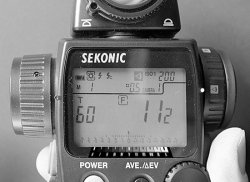- Joined
- Sep 22, 2017
- Messages
- 300
The most important tool I ever have bought was a Sekonic spotmeter.
Now I'm able to meter two or more points on the object I want to take on film.
I take, for example, my fomapan 100 with 100 ASA and set ISO on Sekonic to 100.
Than I measure on the brightest point I want to get nearly white and save that value. Second metering is on the darkest area I want to get, probably not the darkest one and also save that value.
Than I press the average button get the middle of both values and shot with this.
Tested this severals times and it really worked fine for me.
It even shows details in all areas I want to get on the sheet of film.
It also works if I use a filter, orange or yellow-green, hold this in front of the spotmeter and got perfect negatives.
I add bellow extension and black shield effect values too. There's a nice little tool on my cellphone, Inverso on android.
Is there something to make this better, except testing film and developing before all of this.
I'm short before using a old Sinar norma with 5x7 where negatives are € 84,-- for 25 sheets of film and I don't want to mistreat them.
and I don't want to mistreat them.
Probably important to know I print in a traditional darkroom with beautiful materials like Agfa Brovira and so on.
Having heard you have to get all information on your negativ for creating the big sound of a print.
Now I'm able to meter two or more points on the object I want to take on film.
I take, for example, my fomapan 100 with 100 ASA and set ISO on Sekonic to 100.
Than I measure on the brightest point I want to get nearly white and save that value. Second metering is on the darkest area I want to get, probably not the darkest one and also save that value.
Than I press the average button get the middle of both values and shot with this.
Tested this severals times and it really worked fine for me.
It even shows details in all areas I want to get on the sheet of film.
It also works if I use a filter, orange or yellow-green, hold this in front of the spotmeter and got perfect negatives.
I add bellow extension and black shield effect values too. There's a nice little tool on my cellphone, Inverso on android.
Is there something to make this better, except testing film and developing before all of this.
I'm short before using a old Sinar norma with 5x7 where negatives are € 84,-- for 25 sheets of film
Probably important to know I print in a traditional darkroom with beautiful materials like Agfa Brovira and so on.
Having heard you have to get all information on your negativ for creating the big sound of a print.


